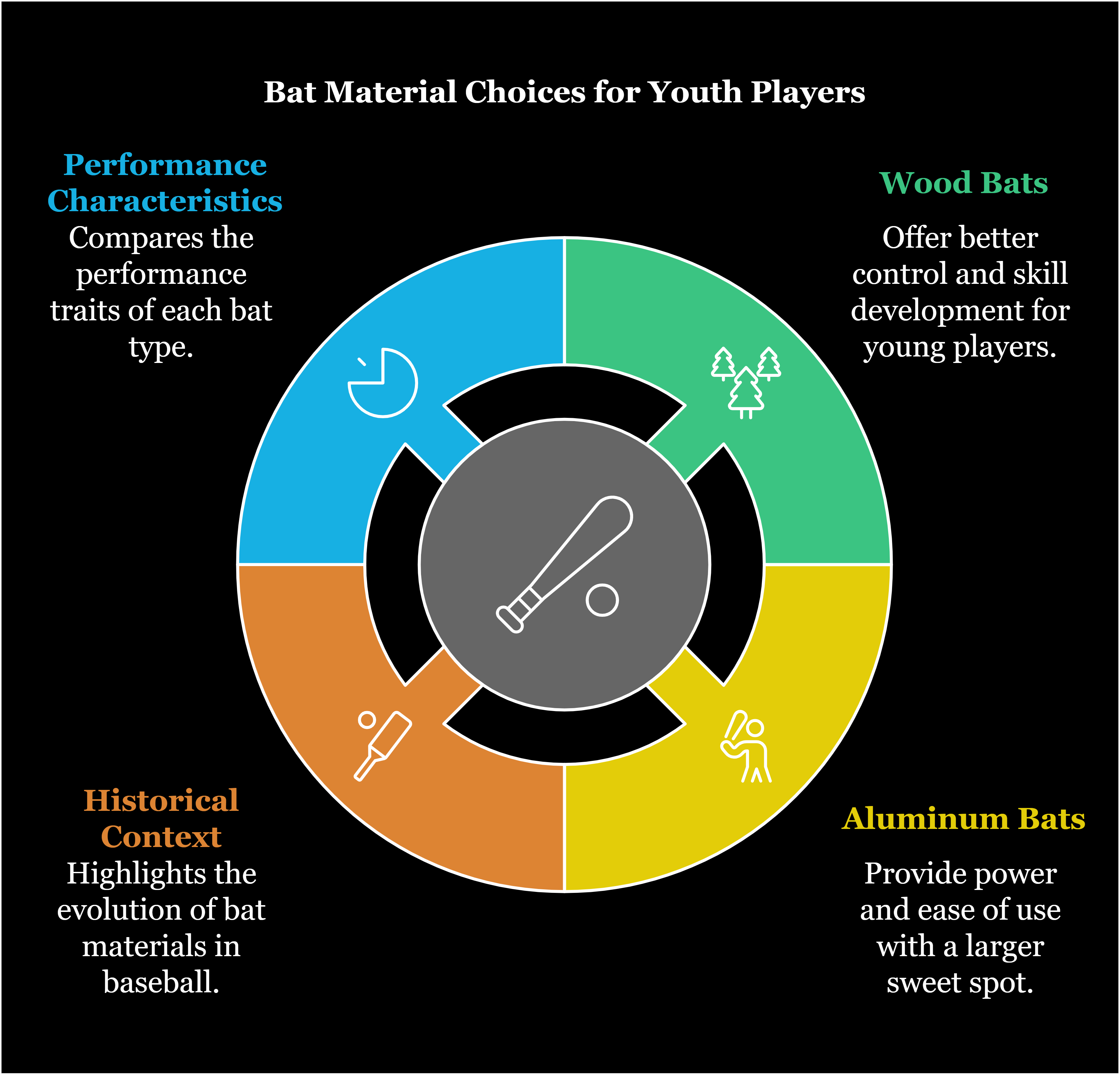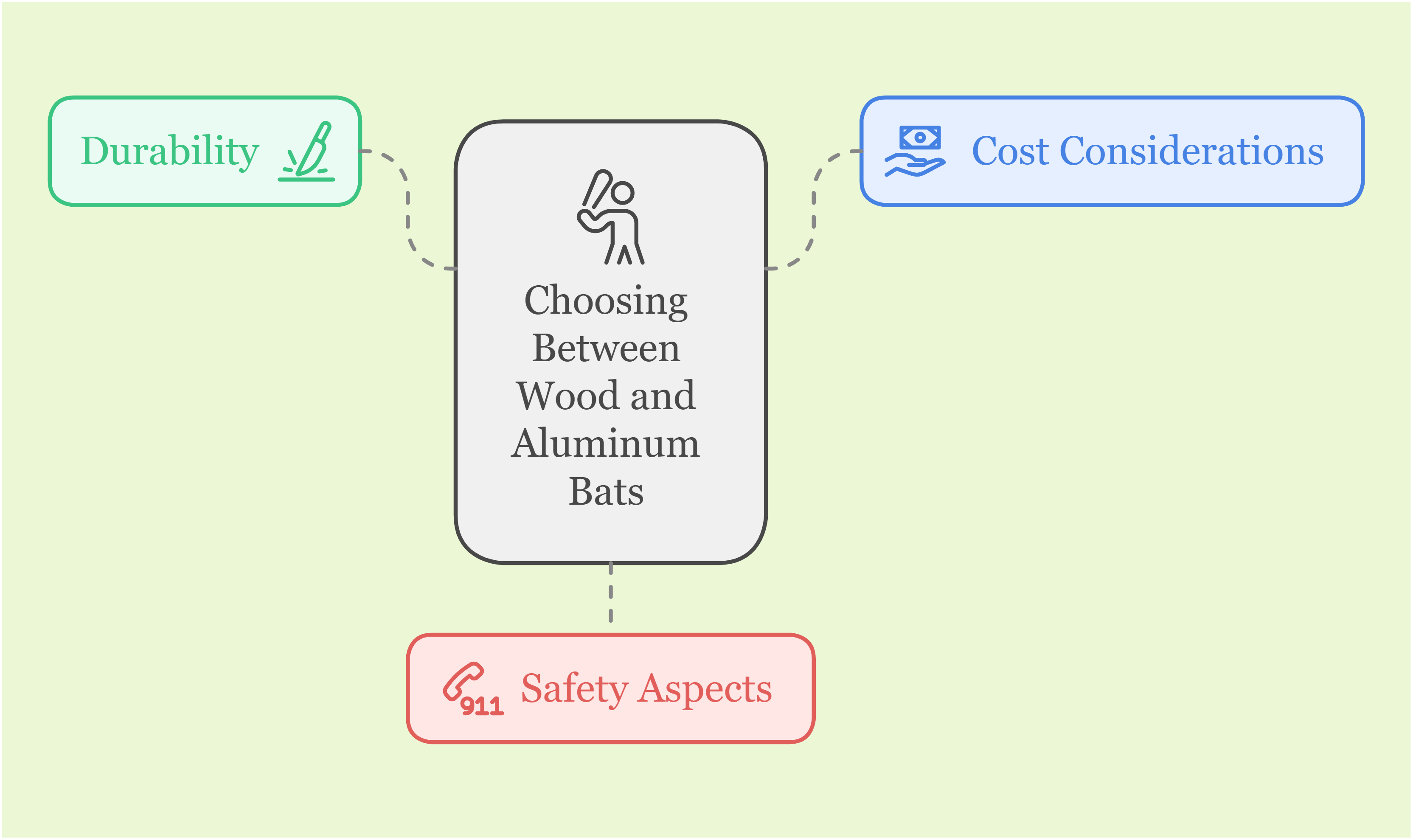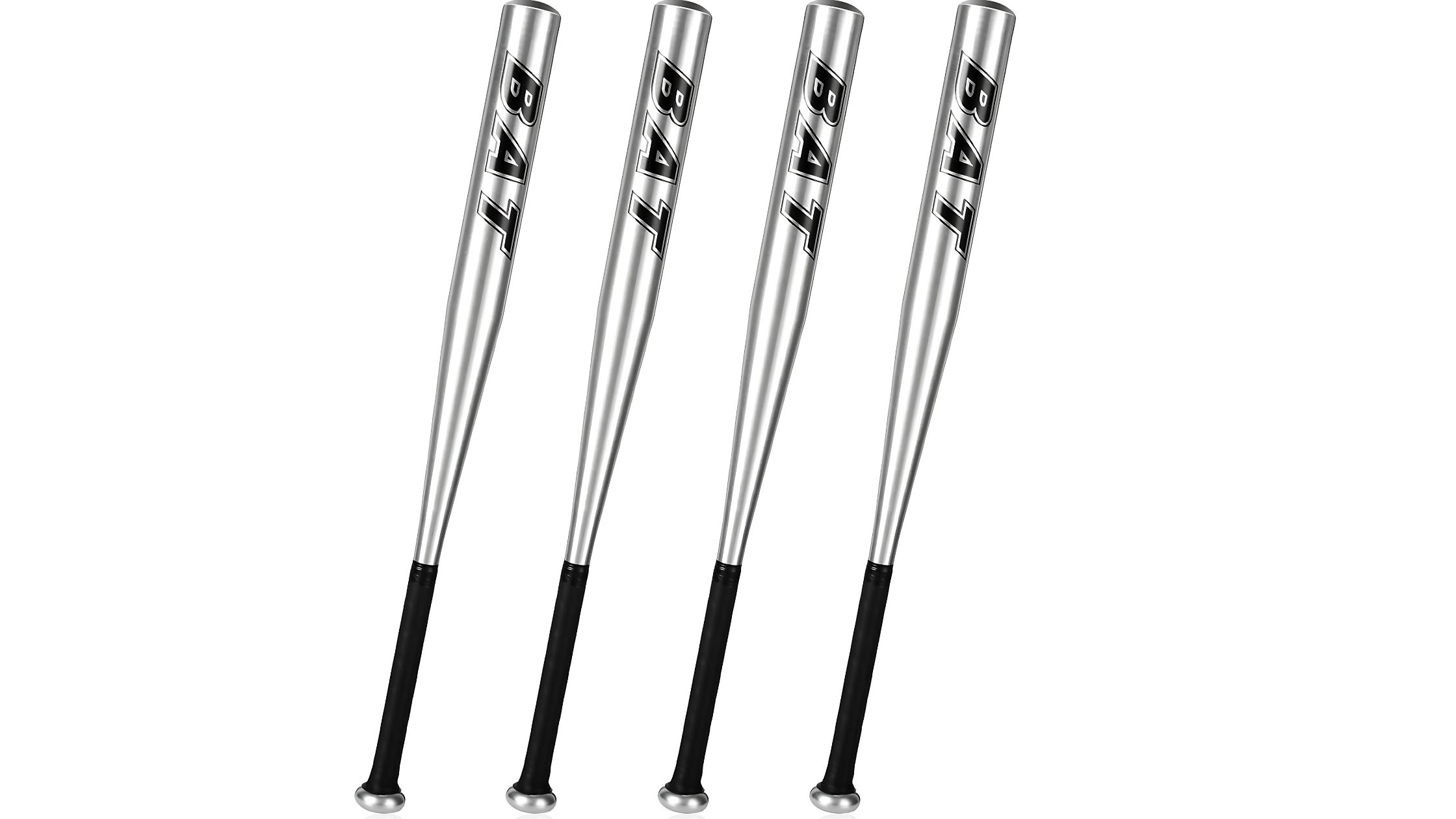**Wood Vs. Aluminum Bats: Which is Better for Youth Players? ** Aluminum bats are generally better for youth players due to their lighter weight and larger sweet spot.
Wood bats help develop better hitting mechanics. Choosing the right bat is crucial for young baseball players. Aluminum bats offer several advantages, such as increased power and ease of use. Their lighter weight allows for faster swing speeds, making it easier for young players to make contact.
Wood bats, on the other hand, help players develop proper hitting techniques and offer a more authentic baseball experience. They require more precision and strength, which can be beneficial for skill development. Understanding the pros and cons of each type of bat helps parents and coaches make informed decisions, ensuring young players have the best tools to succeed on the field.
Introduction To Bat Materials
Choosing the right bat for youth players can be confusing. The two main materials are wood and aluminum. Both have unique benefits and drawbacks. In this post, we will explore these materials in detail.
Historical Background
Wooden bats have been used since the early days of baseball. Historically, they were the only option available. Famous players like Babe Ruth used wooden bats. Aluminum bats were introduced in the 1970s. They quickly became popular, especially in youth leagues.
Importance For Youth Players
For youth players, the choice of bat material is crucial. It can affect performance and safety. Aluminum bats are lighter and easier to swing. This helps young players hit the ball farther. Wooden bats are heavier but offer better control. They also teach players proper hitting techniques.

| Criteria | Wood Bats | Aluminum Bats |
|---|---|---|
| Weight | Heavier | Lighter |
| Durability | Less durable | More durable |
| Cost | More expensive | Less expensive |
| Performance | Better control | Greater power |
Both materials have their pros and cons. Parents and coaches should consider these factors. The right bat can help youth players improve their game. It can also ensure they enjoy playing baseball.
Wood Bats
Choosing the right bat is crucial for youth players. Wood bats offer unique benefits that can influence their performance. This section will explore the different types of wood and their performance characteristics.
Types Of Wood
Wood bats come from various types of trees. Each type has its own advantages:
- Ash: Ash bats are flexible and lightweight. This makes them easier to swing.
- Maple: Maple bats are dense and hard. They offer more power but can be heavy.
- Bamboo: Bamboo bats are durable and strong. They are also eco-friendly.
- Birch: Birch bats combine flexibility and hardness. This provides a balanced feel.
Performance Characteristics
Wood bats can enhance a player’s skills in several ways:
- Improved Bat Control: Wood bats have smaller sweet spots. This helps players focus on precision.
- Better Feedback: Players can feel the impact better with wood bats. This improves their swing mechanics.
- Increased Strength: Swinging a wood bat builds muscle strength. This is beneficial for young athletes.
Here’s a table summarizing the key features of each type of wood:
| Type of Wood | Flexibility | Density | Durability |
|---|---|---|---|
| Ash | High | Medium | Medium |
| Maple | Low | High | High |
| Bamboo | Medium | Medium | Very High |
| Birch | Medium | Medium-High | High |
Aluminum Bats
Aluminum bats are popular among youth baseball players. They are known for their light weight and durability. Many young players prefer aluminum bats because they are easy to handle and offer good performance.

Material Composition
Aluminum bats are made from an aluminum alloy. This material is light and strong. The bats are crafted by mixing aluminum with other metals. This combination makes the bat durable and efficient.
Aluminum bats often have a hollow core. This design reduces the weight of the bat. A lighter bat is easier for young players to swing. The handle is usually wrapped in a grip tape. This provides better control and comfort.
Performance Characteristics
Aluminum bats are known for their high performance. The light weight allows for faster swings. Faster swings can result in harder hits and longer distances.
Aluminum bats also have a larger sweet spot. The sweet spot is the part of the bat that hits the ball best. A larger sweet spot makes it easier to hit the ball well. This can boost a young player’s confidence and performance.
These bats also produce a distinctive “ping” sound. The sound can be satisfying for many players. Aluminum bats are also very durable. They can withstand many hits without breaking.
Here is a quick comparison of key features:
| Feature | Aluminum Bat |
|---|---|
| Weight | Light |
| Durability | High |
| Sweet Spot | Large |
| Sound | Ping |
Durability
When choosing between wood and aluminum bats for youth players, durability is a key factor. Each material has its own strengths and weaknesses in terms of longevity. Let’s dive into the durability aspects of both wood and aluminum bats.
Wood Bat Longevity
Wood bats are made from different types of wood, such as ash, maple, and birch. These types of wood have unique characteristics that affect their durability.
- Ash: Ash bats are flexible and provide a large sweet spot. They tend to last longer because they can absorb shock well.
- Maple: Maple is dense and hard, making it less flexible. This hardness can lead to cracks and breaks.
- Birch: Birch combines flexibility and hardness, offering a balanced option. It tends to have a moderate lifespan.
Wood bats can break if hit in the wrong spot. Frequent replacements might be needed, especially for aggressive hitters.
Aluminum Bat Longevity
Aluminum bats are made from metal alloys, making them more durable than wood bats. They are less likely to break or crack.
- Alloy Composition: The specific alloy mix impacts the bat’s strength. Higher quality alloys tend to last longer.
- Construction: Some aluminum bats have reinforced barrels, which increases their lifespan.
Aluminum bats can dent over time but usually last several seasons. They are more cost-effective due to their longer lifespan.
| Feature | Wood Bats | Aluminum Bats |
|---|---|---|
| Material | Ash, Maple, Birch | Metal Alloys |
| Durability | Prone to cracks and breaks | Resistant to breaks, may dent |
| Lifespan | Shorter, needs frequent replacements | Longer, lasts several seasons |
Cost Considerations
When choosing between wood and aluminum bats for youth players, cost considerations play a crucial role. This section will help you understand the financial aspects of both types of bats. We’ll break it down into initial investment and long-term costs.

Initial Investment
The initial investment can vary significantly between wood and aluminum bats. Here’s a quick comparison:
| Type of Bat | Average Cost |
|---|---|
| Wood Bat | $30 – $100 |
| Aluminum Bat | $50 – $300 |
Wood bats are generally more affordable initially. Aluminum bats tend to have a higher upfront cost. This can be a significant factor for parents and coaches.
Long-term Costs
The long-term costs also differ between wood and aluminum bats. Here are some factors to consider:
- Durability: Aluminum bats last longer than wood bats.
- Replacement Frequency: Wood bats break more easily, needing frequent replacement.
- Maintenance: Aluminum bats require less maintenance.
Over time, the costs can add up. Aluminum bats might seem expensive initially. But their durability can make them more cost-effective in the long run.
To sum up, wood bats have a lower initial cost but higher long-term costs due to frequent replacements. Aluminum bats cost more upfront but might save money over time due to their durability.
Safety Aspects
Choosing the right bat for youth players involves many factors. One crucial aspect is safety. Parents and coaches need to understand the injury risks and regulations surrounding wood and aluminum bats.
Injury Risks
Wood bats tend to have a smaller sweet spot. This makes them less powerful than aluminum bats. As a result, balls hit with wood bats may have lower exit velocities. This can reduce the risk of serious injuries to fielders.
Aluminum bats are lighter and have a larger sweet spot. They allow players to hit the ball harder and faster. But this increased power can lead to higher injury risks for pitchers and infielders. Balls coming off aluminum bats can travel at dangerous speeds.
Here’s a comparison table to illustrate the injury risks:
| Bat Type | Sweet Spot | Ball Exit Speed | Injury Risk |
|---|---|---|---|
| Wood | Smaller | Lower | Reduced |
| Aluminum | Larger | Higher | Increased |
Regulations And Standards
Different leagues have specific rules for bat usage. These rules aim to ensure player safety. For example, some leagues only allow wood bats. This rule helps to limit the power of hits and protect players.
Other leagues permit aluminum bats but with restrictions. These bats must meet certain standards to be approved for play. The Bat Performance Factor (BPF) is often used to measure how much energy the bat transfers to the ball. A lower BPF means less power and lower injury risks.
Here are some key regulations and standards:
- Wood bats often required for younger age groups.
- Aluminum bats must meet BBCOR standards in high school leagues.
- Little League has its own set of approved bat lists.
Understanding these regulations can help you choose the safest bat for your youth player.
Performance Differences
When choosing between wood and aluminum bats for youth players, performance differences play a crucial role. Understanding these differences can help players and parents make the best decision.

Swing Speed
Youth players often find aluminum bats easier to swing. Aluminum bats are generally lighter than wood bats. This lighter weight allows for a faster swing speed. Faster swings mean the player can hit the ball more effectively.
Wood bats are heavier, requiring more strength to swing. This can be a disadvantage for younger players. The increased weight can slow down their swing. A slower swing speed can impact the player’s performance.
Ball Exit Speed
Aluminum bats can significantly impact ball exit speed. The ball tends to travel faster off an aluminum bat. This is due to the “trampoline effect” where the bat flexes and then snaps back. This effect gives the ball added velocity.
Wood bats, on the other hand, have a more traditional feel. The ball exit speed is generally lower compared to aluminum. The denser material absorbs more of the ball’s energy. This results in slower ball exit speeds.
| Aspect | Aluminum Bat | Wood Bat |
|---|---|---|
| Swing Speed | Faster | Slower |
| Ball Exit Speed | Higher | Lower |
Choosing the right bat can significantly affect a youth player’s game. Whether prioritizing swing speed or ball exit speed, understanding these performance differences is essential.
Player Development
Choosing the right bat impacts a youth player’s growth. Both wood and aluminum bats offer unique benefits. Understanding these can help in making the best decision for young athletes.

Skill Enhancement
Wood bats help players improve their hitting skills. They have a smaller sweet spot. This forces players to focus on their swing mechanics. Using wood bats can make players more precise hitters.
Aluminum bats are lighter and easier to handle. They help players achieve better bat speed. This can boost confidence and make the game more enjoyable for young players.
Transition To Higher Levels
Players using wood bats may find it easier to transition to higher levels. High school and professional leagues often use wood bats. Early exposure can make this switch smoother.
Aluminum bats are common in youth and college leagues. They help players adjust to competitive play. The performance benefits can help players stand out in early stages.
| Aspect | Wood Bats | Aluminum Bats |
|---|---|---|
| Weight | Heavier | Lighter |
| Sweet Spot | Smaller | Larger |
| Durability | Less Durable | More Durable |
| Skill Development | Better Precision | Better Speed |
Frequently Asked Questions
Which Bat Is Better For Youth Players?
Wood bats offer better training benefits. Aluminum bats are more durable and provide better performance. Choosing depends on specific needs.
Do Wood Bats Break Easily?
Yes, wood bats can break more easily than aluminum bats. However, they help develop better hitting mechanics.
Are Aluminum Bats Safer For Kids?
Aluminum bats can hit balls harder and faster. This might increase the risk of injury compared to wood bats.
What Are The Costs Of Wood Vs. Aluminum Bats?
Wood bats are generally cheaper but may need frequent replacement. Aluminum bats are costlier but last longer.
Conclusion
Choosing between wood and aluminum bats depends on the player’s needs and league rules. Wood bats improve technique, while aluminum bats offer better performance. Consider your budget, player skill level, and league regulations. Both options have their advantages, so make an informed choice for the best results on the field.


